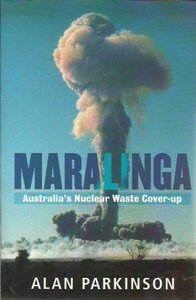
The Atomic Age, also known as the Atomic Era, is the period of history following the detonation of the first nuclear weapon, The Gadget at the Trinity test in New Mexico, on 16 July 1945, during World War II. Although nuclear chain reactions had been hypothesized in 1933 and the first artificial self-sustaining nuclear chain reaction had taken place in December 1942, the Trinity test and the ensuing bombings of Hiroshima and Nagasaki that ended World War II represented the first large-scale use of nuclear technology and ushered in profound changes in sociopolitical thinking and the course of technological development.

Blue Danube was the first operational British nuclear weapon. It also went by a variety of other names, including Smallboy, the Mk.1 Atom Bomb, Special Bomb and OR.1001, a reference to the Operational Requirement it was built to fill.

Maralinga, in the remote western areas of South Australia, was the site, measuring about 3,300 square kilometres (1,300 sq mi) in area, of British nuclear tests in the mid-1950s.
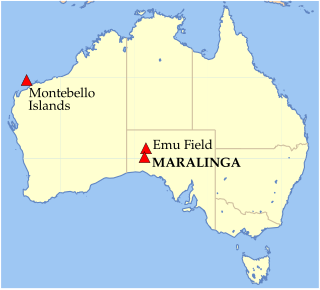
Between 1956 and 1963, the United Kingdom conducted seven nuclear tests at the Maralinga site in South Australia, part of the Woomera Prohibited Area about 800 kilometres (500 mi) north west of Adelaide. Two major test series were conducted: Operation Buffalo in 1956 and Operation Antler the following year. Approximate weapon yields ranged from 1 to 27 kilotons of TNT. The Maralinga site was also used for minor trials, tests of nuclear weapons components not involving nuclear explosions. Kittens were trials of neutron initiators; Rats and Tims measured how the fissile core of a nuclear weapon was compressed by the high explosive shock wave; and Vixens investigated the effects of fire or non-nuclear explosions on atomic weapons. The minor trials, numbering around 550, ultimately generated far more contamination than the major tests.
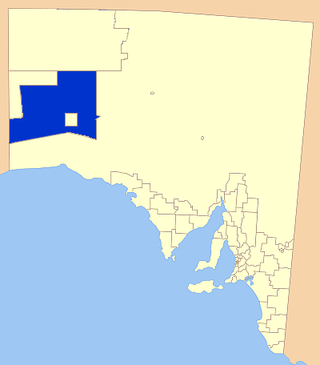
The Maralinga Tjarutja, or Maralinga Tjarutja Council, is the corporation representing the traditional Anangu owners of the remote western areas of South Australia known as the Maralinga Tjarutja lands. The council was established by the Maralinga Tjarutja Land Rights Act 1984. The area is one of the four regions of South Australia classified as an Aboriginal Council (AC) and not incorporated within a local government area.
The McClelland Royal Commission or Royal Commission into British nuclear tests in Australia was an inquiry by the Australian government in 1984–1985 to investigate the conduct of the British in its use, with the then Australian government's permission, of Australian territory and soldiers for testing nuclear weapons. It was chaired by Jim McClelland.

Since the mid-20th century, plutonium in the environment has been primarily produced by human activity. The first plants to produce plutonium for use in cold war atomic bombs were at the Hanford nuclear site, in Washington, and Mayak nuclear plant, in Chelyabinsk Oblast, Russia. Over a period of four decades, "both released more than 200 million curies of radioactive isotopes into the surrounding environment – twice the amount expelled in the Chernobyl disaster in each instance".

Atomic tourism or nuclear tourism is a recent form of tourism in which visitors learn about the Atomic Age by traveling to significant sites in atomic history such as nuclear test reactors, museums with nuclear weapon artifacts, delivery vehicles, sites where atomic weapons were detonated, and nuclear power plants.
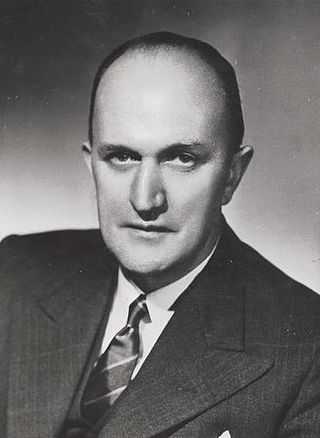
Sir Oliver Howard Beale KBE was an Australian politician and diplomat. He was a member of the Liberal Party and served in the House of Representatives from 1946 to 1958, representing the New South Wales seat of Parramatta. He held ministerial office in the Menzies Government as Minister for Information (1949–1950), Transport (1949–1950), Supply (1950–1958), and Defence Production (1956–1958). He retired from parliament to serve as Australian Ambassador to the United States (1958–1964). His son Julian also entered politics.

Nuclear weapons testing, uranium mining and export, and nuclear power have often been the subject of public debate in Australia, and the anti-nuclear movement in Australia has a long history. Its origins date back to the 1972–1973 debate over French nuclear testing in the Pacific and the 1976–1977 debate about uranium mining in Australia.
Alan Parkinson is a mechanical and nuclear engineer who lives in Canberra, Australia. He is also a whistleblower who wrote the 2007 book, Maralinga: Australia’s Nuclear Waste Cover-up which exposed deficiencies in the clean-up of the British atomic bomb test site at Maralinga in South Australia.
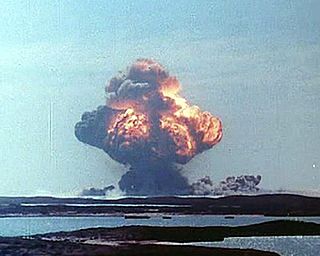
Operation Mosaic was a series of two British nuclear tests conducted in the Montebello Islands in Western Australia on 16 May and 19 June 1956. These tests followed the Operation Totem series and preceded the Operation Buffalo series. The second test in the series was the largest ever conducted in Australia.
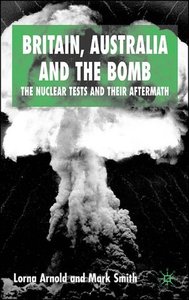
Britain, Australia and the Bomb: the Nuclear Tests and Their Aftermath is a 2006 book by Lorna Arnold and Mark Smith. It is the second edition of an official history first published in 1987 by HMSO under another title: A Very Special Relationship: British Atomic Weapons Trials in Australia. The book uses declassified material that has become available in the two decades prior to the book's publication. It covers the clean-up operations in the Maralinga Range and epidemiological studies on the health of the atomic test participants.

The United Kingdom conducted 12 major nuclear weapons tests in Australia between 1952 and 1957. These explosions occurred at the Montebello Islands, Emu Field and Maralinga.
The World Uranium Hearing was held in Salzburg, Austria in September 1992.Anti-nuclear speakers from all continents, including indigenous speakers and scientists, testified to the health and environmental problems of uranium mining and processing, nuclear power, nuclear weapons, nuclear tests, and radioactive waste disposal.

Following the success of Operation Grapple in which the United Kingdom became the third nation to acquire thermonuclear weapons after the United States and the Soviet Union, Britain launched negotiations with the US on a treaty under in which both could share information and material to design, test and maintain their nuclear weapons. This effort culminated in the 1958 US–UK Mutual Defence Agreement. One of the results of that treaty was that Britain was allowed to use United States' Nevada Test Site for testing their designs and ideas, and received full support from the personnel there, in exchange for the data "take" from the experiment, a mutual condition. In effect the Nevada Test Site became Britain's test ground, subject only to advance planning and integrating their testing into that of the United States. This resulted in 24 underground tests at the Nevada Test Site from 1958 through the end of nuclear testing in the US in September 1992.

Avon Hudson is a South Australian RAAF ex-serviceman, nuclear weapons testing whistle-blower and co-author of the 2005 book Beyond Belief which he wrote with academic and historian, Roger Cross. He has appeared in several documentary films about nuclear weapons testing in Australia.
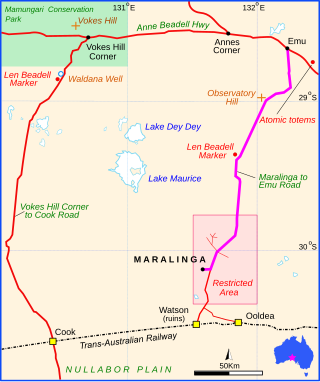
Maralinga to Emu Road is a remote unsealed outback track that links Maralinga to Emu in the western region of South Australia. It was built by Len Beadell for the Weapons Research Establishment of Salisbury, South Australia in 1955.

In 1952, the United Kingdom was the third country to develop and test nuclear weapons, after the United States and Soviet Union. and is one of the five nuclear-weapon states under the Treaty on the Non-Proliferation of Nuclear Weapons.
